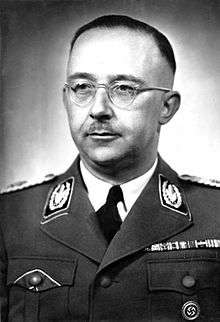Richard Wendler

Richard Wendler (22 January 1898, Oberndorf bei Salzburg – 24 August 1972, Prien am Chiemsee) was a high-ranking Nazi official during World War II. During the occupation of Poland, he was the Governor of new District Lublin in the General Government, in charge of Lublin concentration camp and the creation of the Częstochowa Ghetto, among others. Before his deployment to Poland, he was the mayor of the city Hof between 1933 and 1941 and became an SS-Gruppenführer in 1942 during the murderous Operation Reinhard.[1] Wendler was Reichsführer-SS Heinrich Himmler's brother-in-law; his sister was married to a brother of Himmler.[2]
Biography
Wendler was born the son of a border official, in southeast Bavaria, near the border with Austria. He attended elementary school in Bad Reichenhall and the humanist Ludwigsgymnasium in Munich. Wendler was a soldier during the First World War, reaching the rank of Unteroffizier. From the spring of 1919, he was a member of the Freikorps and participated in the fight against the Bavarian Soviet Republic in 1919 and the suppression of the Ruhr Uprising in 1920.[3] He studied jurisprudence and political science from 1919 to 1922 at the University of Munich, where he received his doctorate of jurisprudence. From 1924, he worked as general counsel in Stuttgart, and completed his studies with his second Staatsexamen in 1925. He then worked as a lawyer in Deggendorf.[4]
His sister Mathilde (called Hilde) married Gebhard Ludwig Himmler, the older brother of the Reichsführer-SS Heinrich Himmler in 1926. Wendler, who founded the local NSDAP group in Deggendorf in 1927, joined the Nazi Party (membership number 93,116) and the SA in July 1928.[4] In early April 1933, as a Sturmbannführer with the SA, he joined the SS (membership number 36,050).[5] He was appointed to the Bavarian Political Police by Himmler.[6] In April 1934, he rose to SS-Obersturmbannführer, to SS-Standartenführer in April 1935, and SS-Gruppenführer in 1941. In early August 1941, he was promoted to Generalmajor der Polizei und SS-Brigadeführer. On 21 July 1943, he was appointed SS-Gruppenführer und Generalleutnant der Polizei.[5]
From October 1933, he was mayor of Hof.[7] He was involved in the demolition of the Jewish Synagogue in Hof, during Kristallnacht in November 1938. Wendler resigned from the office of mayor in 1941.
After the beginning of World War II, Wendler was the city commissioner in Kielce. From early November 1939, he was Stadthauptmann in Częstochowa.[4] In 1940, he took over the same position in Radom, and in this capacity, ordered, among other things, the installation of a ghetto in Częstochowa. From 31 January 1942 to 26 May 1943, he was the governor of the district of Kraków. Thereafter, until 22 July 1944, he was governor of the Lublin district, after which he fled from the advancing Red Army.
In May 1945, he fell into American captivity and went by the false name Kummermehr while there. For this reason, Wendler was not transferred to Poland, but rather released from Allied internment in September 1945. Afterwards, he worked as a construction worker. On 3 August 1948, he was arrested and imprisoned by a Denazification court. On 22 December 1948, as a "Hauptschuldige" (Group I - Major Offender), he was sentenced to four years in a labor camp. In April 1949, the sentence was reduced to three years in prison. During the process, Wendler denied any knowledge of the deportations of Jews. On 12 September 1952, he was classified as "Belastete" (Group 2 - Offender). He was classified as a "Mitläufer" (Group 4 - Follower) by pardon of Bavarian Minister-President Wilhelm Hoegner on 28 October 1955, and thereby was able to again obtain admission to the bar in Munich in 1955. He died in August 1972.
Awards
References
- ↑ Richard Wendler in the German National Library catalogue
- ↑ Charles W. Ingrao, Franz A. J. Szabo (2008), The Germans and the East Purdue University Press p. 293. (Google eBook)
- ↑ Katrin Himmler (2007), The Himmler Brothers. Pan Macmillan, London, 2008, p. 223. (Google eBook)
- 1 2 3 Bogdan Musial: Deutsche Zivilverwaltung und Judenverfolgung im Generalgouvernement. Wiesbaden 1999, p. 398.
- 1 2 Werner Präg, Wolfgang Jacobmeyer (Hrsg.): Das Diensttagebuch des deutschen Generalgouverneurs in Polen 1939–1945. Stuttgart 1975, p. 955.
- ↑ Katrin Himmler (2007), The Himmler Brothers, Macmillan, London, 2008, p. 224
- ↑ Ernst Klee: Das Personenlexikon zum Dritten Reich. Wer war was vor und nach 1945. Second revised edition. Fischer, Frankfurt am Main 2005, ISBN 3-596-16048-0, p. 668.
Bibliography
- Jörg Wurdack: Dr. Richard Wendler; Oberbürgermeister Hofs und Mittäter bei der „Endlösung“ im besetzten Polen. In: Miscellanea curiensia. VII, Hof 2008, ISBN 978-3-928626-57-6, p. 99–133. (56. Bericht des Nordoberfränkischen Vereins für Natur-, Geschichts- und Landeskunde)
- Katrin Himmler, The Himmler Brothers. Macmillan, London, 2007, ISBN 978-0-330-44814-7.
- Bogdan Musial: Deutsche Zivilverwaltung und Judenverfolgung im Generalgouvernement. Harrassowitz, Wiesbaden 1999, ISBN 3-447-04208-7. (second unrevised edition, Harrassowitz, 2004, ISBN 3-447-05063-2)
- Werner Präg, Wolfgang Jacobmeyer (Hrsg.): Das Diensttagebuch des deutschen Generalgouverneurs in Polen 1939–1945. Stuttgart 1975, ISBN 3-421-01700-X (Veröffentlichungen des Instituts für Zeitgeschichte, Quellen und Darstellungen zur Zeitgeschichte Band 20).
- Markus Roth: Herrenmenschen. Die deutschen Kreishauptleute im besetzten Polen – Karrierewege, Herrschaftspraxis und Nachgeschichte. Wallstein Verlag, Göttingen 2009, ISBN 978-3-8353-0477-2.
Further reading
- Himmler, Katrin (2007). "Chapter 13: 'Ever Your Faithful Richard': Richard Wendler and His Brother-In-Law". The Himmler Brothers. Pan Macmillan. pp. 221–239. ISBN 978-1-234-56789-7.
